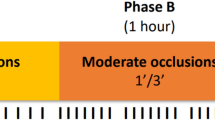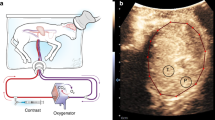Abstract
The aim of this study was to determine whether asphyxia induced by clinically relevant, brief repetitive umbilical cord occlusions is associated with cerebral compromise. Chronically instrumented fetal lambs were studied at 126.5 ± 2.8 d of gestation (mean ± SD, term 147 d). Occlusions were performed 1 out of every 2.5 min (group I, n = 7), 2 out of every 5 min (group II, n = 9), or not at all (shams, group III,n = 5), and discontinued at a predetermined threshold of severe or persistent hypotension. After 58 ± 8 and 24 ± 2 occlusions, in groups I and II, respectively, the pH was 6.83 ± 0.09, Pco2 9.52± 1.4 kPa, base excess -23.5 ± 3.7 mM, and lactate 14.1 ± 1.6 mM. Two fetuses (out of group II) did not recover from the final occlusion. Ongoing asphyxia was associated with progressive suppression of the EEG, which occurred faster and with more epileptiform and spike activity in group II. Cortical impedance remained elevated for 15.0 ± 4.0 and 11.5± 4.4 h, for groups I and II, respectively (NS). Focal infarcts occurred in the parasagittal cortex, thalamus, and cerebellum, in 6 out of 14 surviving asphyxiated fetuses. Mild selective neuronal loss was observed in these regions in 13 out of 14 fetuses. Infarction was associated with a longer period of blood pressure below baseline levels, with more epileptiform activity, and with slower normalization of the EEG. In a paradigm mimicking birth asphyxia, histologic damage similar to that observed clinically was found. The results suggest that brief repeated insults interact, leading to cardiac compromise and cumulative cell membrane damage in the fetal cerebrum.
Similar content being viewed by others
Log in or create a free account to read this content
Gain free access to this article, as well as selected content from this journal and more on nature.com
or
References
de Haan HH, Hasaart THM 1995 Neuronal death after perinatal asphyxia. Eur J Obstet Gynecol Reprod Biol 61: 123–127.
Volpe JJ 1995 Hypoxic-ischemic encephalopathy: neuropathology and pathogenesis. In: Saunders WB (ed) Neurology of the Newborn, 3rd Ed. WB Saunders, Philadelphia, pp 279–313.
Iwamoto HS, Stucky E, Roman CM 1991 Effect of graded umbilical cord compression in fetal sheep at 0.6-0.7 gestation. Am J Physiol 261:H1268–H1274.
Mallard EC, Gunn AJ, Williams CE, Johnston BM, Gluckman PD 1992 Transient umbilical cord occlusion causes hippocampal damage in the fetal sheep. Am J Obstet Gynecol 167: 1423–1430.
Mallard EC, Waldvogel HJ, Williams CE, Faull RLM, Gluckman PD 1995 Repeated asphyxia causes loss of striatal projection neurons in the fetal sheep brain. Neuroscience 65: 827–836.
Papile L, Rudolph AM, Heymann MA 1985 Autoregulation of cerebral blood flow in the preterm fetal lamb. Pediatr Res 19: 159–161.
Gunn AJ, Parer JT, Mallard EC, Williams CE, Gluckman PD 1992 Cerebral histological and electrophysiological changes after asphyxia in fetal sheep. Pediatr Res 31: 486–491.
Williams CE, Gunn AJ, Gluckman PD 1991 The time course of intracellular edema and epileptiform activity following prenatal cerebral ischemia in sheep. Stroke 22: 516–521.
Verheul B, Balazs R, Vandersprenkel JWB, Tulleken CAF, Nicolay K, Tamminga KS, Campagne MV 1994 Comparison of diffusion-weighted MRI with changes in cell volume in a rat model of brain injury. NMR Biomed 7: 96–100.
Williams CE, Gunn AJ, Mallard EC, Gluckman PD 1992 Outcome after ischemia in the developing sheep brain: an electroencephalographic and histological study. Ann Neurol 31: 14–21.
Johnston BM, Mallard EC, Williams CE, Gluckman PD 1996 Insulin-like growth factor-1 is a potent neuronal rescue agent following hypoxic-ischemic injury in fetal lambs. J Clin Invest 97: 300–308.
Gotman J 1982 Automatic recognition of epileptic seizures in the EEG. Electroencephalogr Clin Neurophysiol 54: 530–540.
Klein HC, Krop Van Gastel W, Go KG, Korf J 1993 Prediction of specific damage or infarction from the measurement of tissue impedance following repetitive brain ischaemia in the rat. Neuropathol Appl Neurobiol 19: 57–65.
Tan WKM, Williams CE, Gunn AJ, Mallard EC, Gluckman PD 1993 Pretreatment with monosialoganglioside GM1 protects the brain of fetal sheep against hypoxic-ischemic injury without causing systemic compromise. Pediatr Res 34: 18–22.
de Haan HH, Van Reempts JLH, Vles JSH, de Haan J, Hasaart THM 1993 Effects of asphyxia on the fetal lamb brain. Am J Obstet Gynecol 169: 1493–1501.
Aso K, Scher MS, Barmada MA 1990 . Cerebral infarcts and seizures in the neonate. J Child Neurol 5: 224–228.
Kuenzle C, Baenziger O, Martin E, Thunhohenstein L, Steinlin M, Good M, Fanconi S, Boltshauser E, Largo RH 1994 Prognostic value of early MR imaging in term infants with severe perinatal asphyxia. Neuropediatrics 25: 191–200.
Dobbing J, Sands J 1979 Comparative aspects of the brain growth spurt. Early Hum Dev 3: 79–83.
Hill A, Volpe JJ 1981 Seizures, hypoxic-ischemic brain injury, and intraventricular haemorrhage in the newborn. Ann Neurol 10: 109–121.
Torvik A 1984 The pathogenesis of watershed infarcts in the brain. Stroke 15: 221–223.
Block BS, Schlafer DH, Wentworth RA, Kreitzer LA, Nathanielsz PW 1990 Intrauterine asphyxia and the breakdown of physiologic circulatory compensation in fetal sheep. Am J Obstet Gynecol 162: 1325–1331.
Reynolds M, Evans C, Reynolds E, Saunders N, Durbin G, Wigglesworth J 1979 Intracranial haemorrhage in the preterm sheep fetus. Early Hum Dev 3: 163–186.
Wells JT, Ment LR 1995 Prevention of intraventricular hemorrhage in preterm infants. Early Hum Dev 42: 209–233.
Tombaugh GC 1994 Mild acidosis delays hypoxic spreading depression and improves neuronal recovery in hippocampal slices. J Neurosci 14: 5635–5643.
Giffard RG, Monyer H, Christine CW, Choi DW 1990 Acidosis reduces NMDA receptor activation, glutamate neurotoxicity, and oxygen-glucose deprivation neuronal injury in cortical cultures. Brain Res 506: 339–342.
Mallard EC, Williams CE, Gunn AJ, Gunning MI, Gluckman PD 1993 Frequent episodes of brief ischemia sensitize the fetal sheep brain to neuronal loss and induce striatal injury. Pediatr Res 33: 61–65.
Lin B, Globus MYT, Dietrich WD, Busto R, Martinez E, Ginsberg MD 1992 Differing neurochemical and morphological sequelae of global ischemia: comparison of single- and multiple insult paradigms. J Neurochem 59: 2213–2223.
Tan WKM, Williams CE, During MJ, Mallard CE, Gunning MI, Gunn AJ, Gluckman PD 1996 Accumulation of cytotoxins during the development of seizures and edema after hypoxic-ischemic injury in late gestation fetal sheep. Pediatr Res 39: 791–797.
Tyson GW, Teasdale GW, Graham DI, McCulloch J 1984 Focal cerebral ischemia in the rat: topography of hemodynamic and histopathological changes. Ann Neurol 15: 559–564.
Murata Y, Quilligan EJ, Ninomiya Y, Wakatsuki A, Masaoka N, Oka S, Fujimori K 1994 Variable fetal heart rate decelerations and electrocortical activities. Am J Obstet Gynecol 170: 689–692.
Watanabe T, Okamura K, Tanigawara S, Shintaku Y, Akagi K, Endo H, Yajima A 1992 Change in electrocardiogram T-wave amplitude during umbilical cord compression is predictive of fetal condition in sheep. Am J Obstet Gynecol 166: 246–255.
Akagi K, Okamura K, Endo C, Saito J, Tanigawara S, Shintaku Y, Watanabe T, Sato A, Yajima A 1988 The slope of fetal heart rate deceleration is predictive of fetal condition during repeated umbilical cord compression in sheep. Am J Obstet Gynecol 516: 522
Clapp JF, Peress NS, Wesley M, Mann LI 1988 Brain damage after intermittent partial cord occlusion in the chronically instrumented fetal lamb. Am J Obstet Gynecol 159: 504–509.
Author information
Authors and Affiliations
Additional information
Supported by U.S. Public Health Service Grant RO1-HD-32752-01, the Auckland Medical Research Foundation, the New Zealand Lotteries Board, and the Health Research Council of New Zealand. The postdoctoral research fellowship of H.H.d.H. was financially supported by the Niels Stensen Stichting, Amsterdam, the Netherlands.
Rights and permissions
About this article
Cite this article
De Haan, H., Gunn, A., Williams, C. et al. Brief Repeated Umbilical Cord Occlusions Cause Sustained Cytotoxic Cerebral Edema and Focal Infarcts in Near-Term Fetal Lambs. Pediatr Res 41, 96–104 (1997). https://doi.org/10.1203/00006450-199701000-00015
Received:
Accepted:
Issue date:
DOI: https://doi.org/10.1203/00006450-199701000-00015
This article is cited by
-
Fetal brain response to worsening acidosis: an experimental study in a fetal sheep model of umbilical cord occlusions
Scientific Reports (2023)
-
Maintenance of pig brain function under extracorporeal pulsatile circulatory control (EPCC)
Scientific Reports (2023)
-
Cord Blood Proteomic Biomarkers for Predicting Adverse Neurodevelopmental Outcomes in Monoamniotic Twins
Reproductive Sciences (2022)
-
Reliability and characteristics of ultrasound measurement of fetal umbilical venous blood flow volume according to the site of measurement
Journal of Medical Ultrasonics (2020)
-
Should therapeutic hypothermia be offered to babies with mild neonatal encephalopathy in the first 6 h after birth?
Pediatric Research (2019)



